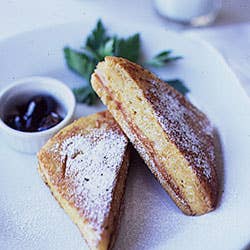
People tend to have strong opinions about the Monte Cristo sandwich—which is, of course, a double-decker of swiss cheese, baked ham, and chicken or turkey, buttered, batter-dipped, panfried or deep-fried, then dusted with confectioners' sugar and served with jelly on the side. Some consider it a marvel (I once heard it described as "fried nirvana"); others, an absurdity ("Why?"). Whatever else it may be, though, it is a stunning gastro-architectural creation, requiring careful assembly and, at the table, a knife and fork. One would assume that its origins would be well documented. They aren't.
It does seem pretty safe to say that the sandwich has nothing to do with the tiny Italian island of Montecristo, nor with the Bolivian town of Monte Cristo. Neither is there any apparent link with Alexandre Dumas's The Count of Monte Cristo—though that novel, published in 1845, did inspire a crop of movies, the most famous being the Robert Donat version, which appeared in 1934, somewhat before the sandwich came into vogue. One theory holds that the Monte Cristo is a Californian elaboration on the croque-monsieur (itself created in Paris in 1910); another possibility is that it derived from the Neapolitan battered and fried cheese sandwich called mozzarella in carrozza—which might sound a bit like "Monte Cristo" to a foreign ear.
Wherever it came from, by the '50s it could be found in diners and hotel dining rooms across America. Helen Evan Brown, in her West Coast Cook Book (1952), suggests that the Monte Cristo originated in San Francisco; she includes not only the basic sandwich, but also the Monte Carlo (made with tongue) and a cocktail variant called the Monte Benito. Sadly, the Monte Cristo almost disappeared in the fat-conscious '80s. Will we see a comeback? We hope so.
Keep Reading
Continue to Next Story










